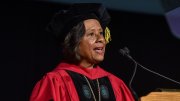Speaking at the Harvard’s Graduate School of Design’s Class Day, climate activist Karenna Gore ’95 noted the “perfect design” of the planet earth. “Well-located, with a good site and orientation,” she said, with plenty of water and land to support inhabitants, and air and sunlight for growing food. And yet, over time, a seismic design flaw has emerged: homo sapiens. Out of the 8.7 million plus species on earth, she continued, one “has become so powerful (and so confused) that it not only threatens many of the others, it threatens the web of life as a whole.”
New design is required to address not only the harm “we are causing to our home,” she said, but to eradicate the root causes of environmental destruction. “We need you,” she told this next generation of architects and designers. “We need your energy, your insights, your work ethic, and especially your creativity.”
Gore is the founder and executive director of the Center for Earth Ethics, a program of the Union Theological Seminary in New York City, from which she also earned a master’s degree in social ethics (following a J.D. from Columbia Law School). The center was formed in 2015 to address moral and spiritual dimensions of the climate crisis. Its public and educational programs and advocacy promote activism aimed at shifting moral consciousness and governing policies. Ethics are crucial to defining action “when a deeply felt and widely shared sense of right and wrong is out of step with both laws and social norms,” she said, as in the case of the abolition of slavery, women’s suffrage, the Civil Rights movement—and the ecological crisis of today. “Most of what drives ecological destruction is not only perfectly legal,” she added, “it is socially encouraged.”
“As the human population continues to grow and as lifestyles in our part of the world are ever more consumerist, and ever more exported, these climate impacts are accelerating in pace and scale,” she said. Chemical and plastic waste piles up “at the poles, in the deepest parts of the oceans, in human blood and urine and breast milk.” Habitats are disappearing for animals, plants, and humans, too. And yet, despite that many understand that this is only the beginning of the decline, “and more and more people do feel a deep sense of uneasiness about it,” she said, “we mainly carry on.”
Even proponents enacting changes to combat the effects of climate change refuse “to address the cause because doing so can disrupt entrenched systems of power,” she pointed out. This includes putting excessive faith in new technologies to capture carbon and investing in the development of solar radiation management (“releasing reflective particles into the stratosphere to reflect back the sunlight to cool things down”) instead of “stopping the emissions from happening in the first place.” Meanwhile, she said, the real, foundational issue gets lost: “It is not the earth that needs fixing, it is us.”
It’s easy to see how the built environment has been shaped by previous mandates. Those supporting traditional forms of economic growth, automobiles, single-family homes on large lots, etc., she noted, make the natural world and its resources merely irrelevant “externalities.”
New paradigms are required, new forms and functions and systems created to mitigate root causes and redress damage. She recalled the theologian Thomas Berry, who also studied geology and topography, and his idea that “the ‘Great Work’ of our time is to realize that the universe is a ‘communion of subjects, not a collection of objects.’” She referenced some hopeful signs of progress. Increasing recognition that landscape features such as waterways, trees, and soil are “vibrant and alive rather than merely scenic or decorative.” The rise of restoration ecology “focuses on repairing biocultural relationships between people and the ecosystems they live in as much as it focuses on repairing the landscape itself.” There’s growing awareness, as indigenous musician, scholar, and community organizer Lyla June Johnston has said, that agricultural systems should be reframed as “making homes for our food.” Gore also noted continuing efforts to “make cities more responsive to people rather than cars, and more inclusive of nature for all who live there.”
As young creatives—those who will build new infrastructure and systems—members of the class of 2024 can create buildings that “not only emit less carbon,” Gore said, but that “can begin to sequester it and generate their own energy. In their own way, buildings can become better members of society, adapting to their surroundings, monitoring their own energy use, limiting emissions, participating with nature instead of competing against it.”
Ultimately, designers, as critical thinkers who aspire to innovate, to push beyond the given norms, “can help us to rethink the economic development model itself,” she said, and do the hard work of pushing forward against formidable obstacles. They can ask, and answer, radical questions pertinent to purpose, meaning, and sustainability—like the one posed by Bengali poet and educator Rabindranath Tagore: “Progress towards what, and progress for whom?”









